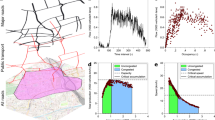Abstract
Disparate evidence indicates that the provision of extra road capacity results in a greater volume of traffic. The amount of extra traffic must be heavily dependent on the context, size and location of road schemes, but an appropriate average value is given by an elasticity of traffic volume with respect to travel time of about −0.5 in the short term, and up to −1.0 in the long term. As a result, an average road improvement has induced an additional 10% of base traffic in the short term and 20% in the long term: individual schemes with induced traffic at double this level may not be very unusual, especially for peak periods. Induced traffic is particularly seen on the alternative routes that road improvements are intended to relieve.
Similar content being viewed by others
References
Beardwood J & Elliott J (1986) Roads Generate Traffic. Proceedings of PTRC Summer Annual Meeting.
Bressey C & Lutyens E (1938) Highway Development Survey 1937. Ministry of Transport. HMSO.
Castle A & Lawrence J (1987) Leigh Bypass: Before and After Studies. Greater Manchester Transportation Unit.
Centre for Economics & Business Research (1994) Roads and Jobs, British Road Federation, London.
Cleary EJ & Thomas RE (1973) The Economic Consequences of the Severn Bridge and its Associated Motorways. Bath University Press.
Department of Transport (1993) Comparison of Forecast and Observed Traffic on Trunk Road Schemes. Highways Economics and Traffic Appraisal Division.
Downes JD & Emmerson P (1983) Do Higher Speeds Increase Travel or Save Time? Transport and Road Research Laboratory, Crowthorne.
Glanville WH & Smeed RJ (1958) The Basic Requirements for the Roads of Great Britain. ICE Conference on the Highway Needs of Great Britain, 13–15 November 1957, Institution of Civil Engineers, London.
Goodwin PB (1992) A Review of Demand Elasticities with Special Reference to Short and Long Run Effects of Price Changes. Journal of Transport Economics and Policy.
Gunn HF (1981) Travel Budgets — A Review of Evidence and Modelling Implications. Transportation Research 15A(1).
Halcrow Fox and Associates, Accent Marketing Research and the University of Leeds (1993) Review and Specification of Model Elasticities. Department of Transport.
Harris RCE (1993) Monitoring Department of Transport Traffic Forecasts. Proceedings of PTRC Summer Annual Meeting.
Howard Humphreys & Partners (1993) A Publication Review of Traffic Generation Studies. Evidence for Inquiry on A406 North Circular Road Popes Lane to Western Avenue Improvement.
Hawthorne I & Paulley NJ (1991) Adaptive Responses to Congestion: Literature Survey. Transport and Road Research Laboratory, Crowthorne.
Luk J & Hepburn S (1993) New review of Australian travel demand elasticities, Australian Road Research Board, Victoria.
Mogridge MJM, Holden DJ, Bird J & Terzis GC (1985) The Downs/Thomson paradox and the transportation planning paradox (1987) International Journal of Transport Economics 14: 283–311.
The MVA Consultancy, Institute for Transport Studies at the University of Leeds, and Transport Studies Unit at the University of Oxford (1987) The Value of Travel Time Savings. Policy Journals. Newbury.
Oum TH, Waters WG & Yong J-S (1992) Concepts of Price Elasticity of Transport Demand and Recent Empirical Estimates. Journal of Transport Economics and Policy 26(2).
Pells SR (1989) User Response to New Road Capacity: A Review of the Published Evidence. Working Paper 283, Institute for Transport Studies, Leeds University.
Pizzigallo P & Mayoh J (1989) Manchester Outer Ring Road Portwood to Denton, a Before and After Study. Greater Manchester Transportation Unit.
Purnell S (1985) The Effect of Strategic Network Changes on Traffic Flows. PRA Note 4, BP 105, Greater London Council.
SACTRA (1994) Trunk Roads and the Generation of Traffic. HMSO, London.
Stokes G (1994) Travel time budgets and their relevance for forecasting the future amount of travel, European Transport Forum, PTRC, September.
Virley S (1993) The Effect of Fuel Price Increases on Road Transport CO 2 Emissions. Transport Policy Unit, Department of Transport.
Williams I & Lawlor C (1992) Growth of Traffic on Motorways and Other Trunk Roads. Report by Marcial Echenique & Partners for the TRRL.
Younes B (1990) The Operational Environmental and Economic Impacts of the Rochester Way Relief Road. PhD Thesis, Imperial College, London.
Author information
Authors and Affiliations
Rights and permissions
About this article
Cite this article
Goodwin, P.B. Empirical evidence on induced traffic. Transportation 23, 35–54 (1996). https://doi.org/10.1007/BF00166218
Issue Date:
DOI: https://doi.org/10.1007/BF00166218




